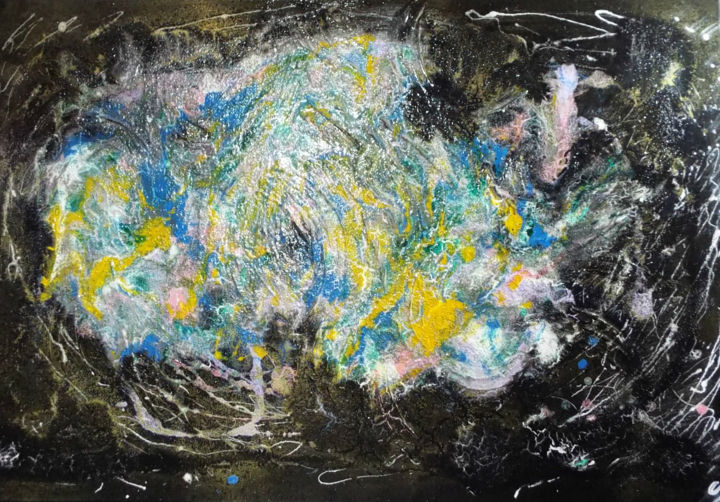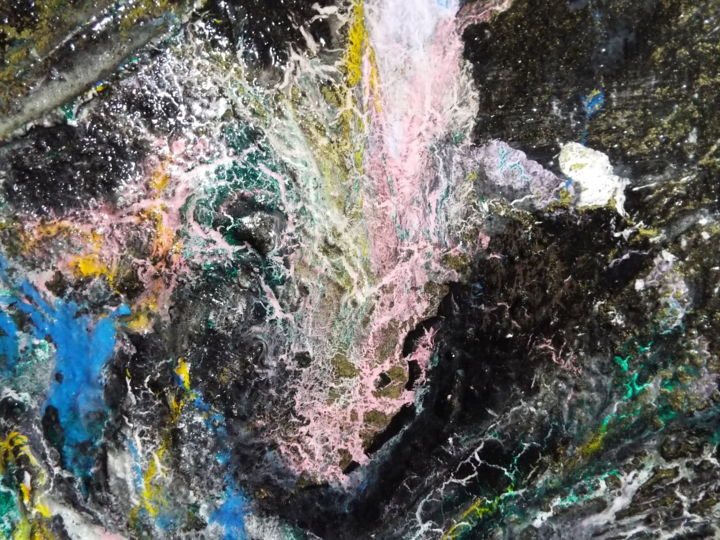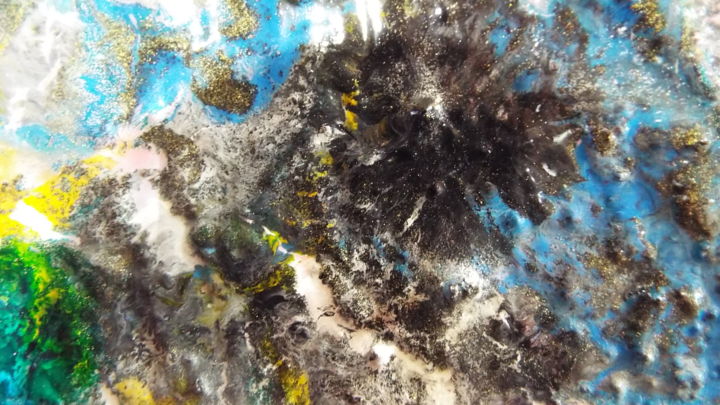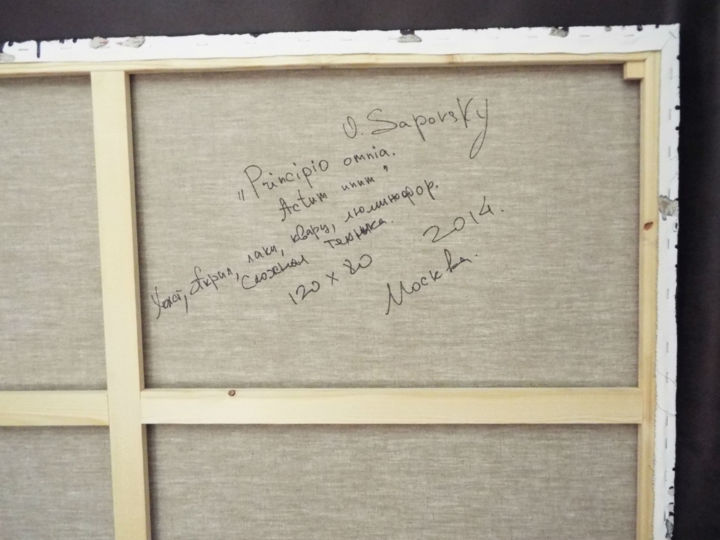





Let us know if you would like to see more photos of this artwork!
- Back of the work / Side of the work
- Details / Signature / Artwork's surface or texture
- Artwork in situation, Other...
Principio Omnia. Actum unum. (2014) Painting by Oleg Sapovsky
Sold by Oleg Sapovsky
This image is available for download with a licence
Sold by Oleg Sapovsky
-
Original Artwork (One Of A Kind)
Painting,
Acrylic
on Canvas
- Dimensions Height 31.5in, Width 47.2in
- Framing This artwork is not framed
- Categories Paintings from $20,000 Abstract
An auction art piece presented here «Principio Omnia. Actum unum» opens up a new stage in this artist's creations. Canvas size: 120х80 sm. Canvas, acrylics, varnishes, quartz, phosphorus. The complex and mixed technique. Date of creation is 2014.
Never before Oleg Sapovsky was deliberately interested in painting because the main occupation of his is the creation of various figurative subjects, realistic for the most part. This painting is one of the nine of "The Beginning of All" series. A tragic experience that had happened to him in 2006 motivated him in creating these series. As a result of thromboembolism, he had suffered a clinical death. While walking his dog he suddenly fell right there on the street. For a while his heart was not beating and he wasn't breathing. He came to consciousness at the front of his residence. Apparently the dog somehow dragged him over there, closer to the people. When the dog was the little pup he saved her life and now the dog had paid him back for his kindness. It was a lucky coincidence that it was a big Alabai dog.
Then there was an ambulance, the hospitals, the surgeries, the disability and so on. The most important thing in this story is not all that but what an artist had "seen" while he was out cold. Something had left an indelible trace in his mind and made him look at things in life differently than before that fateful day. But since the day he'd left the hospital, the artist had the strongest desire to capture everything that he had went through while he was unconscious. As a result of this, he created various pictures, sculptures and interior objects which were made under the impression of what he had witnessed while being "on the other side". He tried to reproduce everything to the smallest detail, to convey all the feelings and emotions that absorbed him completely at that moment. But during the implementation of these plans, a difficult task had arisen. Where and how could he find the expressive means which would be used to accomplish his ideas? After all, it's incredibly difficult to show what cannot be seen and felt but only experienced at the subconscious level. And Oleg Sapovsky, a Realist to the marrow of his bones, did not find anything better than to turn to Abstract Art instead. That is where he could implement to the fullest extent as it turned out.
As the great Picasso wrote: “Painting is a blind man's profession. He paints not what he sees, but what he feels, what he tells himself about what he has seen.”
This is not аn "up-to-the-minute" visual image, but a generalized view of the whole memory. Sapovsky doesn't have any direct teachers and followers and does not affiliate himself with any Art Associations so such a lack of pressure from Academicism allows the artist to go оn his own way in art. His paintings aren't just a non-figurative art, not just a spontaneous set of colors on canvas, not a visualization of the 3D world onto a flat canvas, an imitation of "reality" which we conceive by the image. After all, the abilities of the human eye, our hearing, and other senses are very limited, and we are not capable to perceive everything by ourselves, it is quite a difficult thing to do.
The artist encourages his audience to participate with him in the contemplation of those vivid images that, when looking at them, create the imagination of a person and taking us to the eternal faraway of fantastic space oddity.
The symbols and signs which are formed in the abyss of our consciousness can make the viewer dive into either the deepest existential excitement or ecstatic trance and you can look at them endlessly.
An abstraction by itself is too personal for the perception, which makes the sophisticated art experts and the random audience both feel that they are on the same page. Everything depends on a person's emotional inclination to be able to understand these paintings.
Sapovsky's art is а long and painstaking process despite the seemingly easy way of their creation: a multilayer coating with paints and varnishes; drying up of each layer; a full volume creation; the combination of the different materials and an aggressive influence of external factors like water and temperature changes. He uses various life hacks invented by himself and all of this is done in order to achieve the necessary effects.
He tries to put to virtual his perception of the things, those feelings and emotions that the artist had felt at the time of his transition to another "world". There is no doubt that there was a transition whether it was a parallel world or another planet, or maybe just a hallucination of a dying brain - it is unknown. But the fact remains a fact and we have to deal with it. Each of his paintings is preceded by a long and preparatory work, an arrangement of materials and ultimately a certain psychological setup. As a result, we have got creations which are less connected to our physical world.
In an addition to painting and sculpture, Oleg Sapovsky is now writing a series of books in which he tries to tell an amazing story that had happened to him during those few minutes that he was unconscious. It was a transformation to a completely different world, extraordinarily beautiful and mysterious. Something that is similar to ours, but a bit more virgin and untouched by any technical progress and inhabited by some strange living beings.
They were called the Parumogrinayans. They were strikingly similar to the people but were caricatured somehow. It seemed that Oleg had lived there for his whole lifetime, although his fainting lasted only for a few minutes. The story about the life of the Parumogrinayans, their unusual stories and adventures full of drama and anxiety, comic situations and allegorical images will be in the narrative of the first book. The first edition of the series "Vistianiya. Shadow of Avurus." will be published in 2018.
With the regards to this "Principio omnia. Actum Unum." painting, it can be considered as a bright subject of аn Abstract Art. But not as a simple vision of reality, but as a creation which is "parallel" to our reality. Taking all of this into consideration, the main concept of the idea is an assumption of the possibility that somewhere in the deep layers of the subconscious functions a certain form-building principle that is analogous to what operates in a dream but not similar to it at all.
In a dream, as well as in an artistic creation, an intuition and the subconscious represent the dominant roles. The only difference is that in a dream the images are considered being the reflection of what has been perceived earlier, which is then reproduced later on in a dream, whilst in the process of creativity figures are formed which had no prototypes before neither in the real world nor in the consciousness of their creator.
And the less the artist goes to his own mind and to his own consciousness, the more he draws himself to the intuition; to the instincts; to the dormant mysterious principle, and even more unique and important his works might be. These creations express not only what humanity knows but the very depth of the human psyche.
There is another type of image, not an associative colorful but a sensual one, an image of an obscure form and indefinite colors which, however, comes from the deeper spheres of the unconscious, in the absence of the immediate meaningful associations of the external world. The variety of lines, colors, the blending of tones and shades used independently of any pictorial elements, create an atmosphere of composition and revitalize the movement that seeks to get into the unattainable secrets of the human soul. The masses of intensive color seem to float in the space of the canvas. Their fuzzy outlines create a vibration that is filled with a mysterious magic power. An unearthly light penetrates the canvas and dissolves the tension of forms and the contrasts of color by its own inner shine.
The gloomy colors along the perimeter of the canvas contrast with the light in the central part of the painting, circles and spiral lines with fuzzy edges are dissected by the light spots of the different tones. They penetrate into themselves, mix together and create an unimaginable, inimitable combination of colors.
Bumping into each other they either blend in or fly apart, seemingly setting all the colors in a motion. And while looking at the canvas you involuntarily catch yourself thinking that you yourself are not just a spectator, but a direct participant in this action.
And the more closely you stare at the painting, the more clearly you feel the influence of it on your consciousness. Here it is, an inexplicable element and the birth of life...The unusual texture of the under-paint background only strengthens the impression of what you just saw in front of you.
The artist doesn't just work with colors; he rather puts them in shape by creating a new reality. The bright colors and bizarre forms unite in a single image which can be perceived as an amazing illustration of a fantasy story, kind of like of an exotic labyrinth.
It sucks you inside like a black hole.
Oleg Sapovsky's paintings are the reflection of a free, spontaneous and personal emotional experience and are differentiated by their freedom in the technique of performance and the particular attention in the creation of these works was paid to the changing physical properties of paint in order to emphasize the depicted experience.
He aspires to make the viewer an accomplice in experiencing an absolute color, confirming the idea that the Art should evoke strong emotions, to help a person listen to the inner "self".
Not every time the function of expression of the emotions in a work of art rests on the surface of it and this is absolutely natural since the emotional movements of the human soul are often indistinct, changeable, or even simply mysterious and aren't obvious to the person himself.
"Art does not reproduce the visible; rather, it makes visible." Paul Klee.
This painting has one more unusual feature. As a result of the insignificant use of the phosphorus, it continues to glow like from the inside even when in the complete darkness, creating a simultaneous illusion of a zodiacal glow and the Polar lights.
For some viewers it is the space of the unknown soul, for others it's just a color spot. Depending on what each of us sees in this piece, this painting becomes valuable according to our impressions of what we have seen on it.
Thinking a lot about the objectives of Art, Leo Tolstoy writes: "The Art is a human activity consisting of one person passing on to the others the consciously known external signs of the feelings that he's feeling while the other people become infected by these feelings and they experience them." The emotions have to be not only expressed but also need to inspire the audience. In order to do so, one needs to express them in such a way that the audience experiences the same emotions as the images created by the artist do.
But perhaps it makes sense to follow your feelings and find your own guidelines based on the inner feelings and an aspiration to open up your mind and explore the Unknown.
Due to the complication of the technological process when creating a painting, it is impossible to copy it, for it is much easier just to forge a bank note.
The artist refers to all of his works of recent years as a new style of Art which he has invented by himself. He conditionally called it Vistianism. This is when the artist creates his works in different genres united by one general concept and submitted to one common goal.
This goes the same way for the Fine Arts, the Literature and the Cinema - the pursuit to show a diverse and unknown to anybody world from the different angles. And in this case it is the world of Parumogrinayans.
This includes everything: the Nature surrounding them; the objects of their habitat, and the animals, and their lifestyle, and any other insignificant little things.
The works of Oleg Sapovsky have yet to be studied properly and may be put to the serious objection by the art critics. But undoubtedly the matter of the fact is that we've got a mature and experienced artist with his own incomparable manner of work, which possesses a rich imagination and is very proficient in many techniques for an embodiment of his ideas by the means of any materials available.
The copyrights to own and sell Oleg Sapovsky's works belong to the "ArtaDena" Gallery House in Moscow, Russia.
Related themes
Саповский Олег Владимирович родился в г. Ленинграде в 1962 году.
В области декоративно-прикладного искусства с 1991 года. Долгое время сотрудничал с рядом известных фирм, выполняя их заказы на изготовление мастер-моделей. Авторские произведения скульптора находятся во многих частных коллекциях в России и за рубежом.
Дорога в искусство для Олега Саповского была долгой и тернистой, не сразу он определился с выбором жизненного пути. Пришлось перепробовать множество профессий прежде, чем ваяние стало для него делом жизни. Надо сказать, что Олег Саповский является самоучкой, всё чего он добился, это благодаря своим способностям, пытливому уму и титанической работоспособности. Мастеру подвластна работа с керамикой и фарфором, гипсом и деревом, различными синтетическими материалами ( полиэфирные смолы, искусственный мрамор), с металлом. Однако предпочтение он отдаёт специальному сплаву на основе олова. Работы Олега Саповского являются полностью авторскими, поскольку мастер всё делает сам, от начала и до конца, от лепки в пластилине до литья и обработки металла. Произведения скульптора участвовали во многих выставках: охотничьих, антикварных, ювелирных.
Является членом профессионального союза художников. Автор и художественный руководитель проекта "Высокотехнологичный тематический парк развлечений "Вистиания".
Живёт и работает в Москве.
-
Nationality:
RUSSIA

- Date of birth : 1962
- Artistic domains:
- Groups: Russian Contemporary Artists










